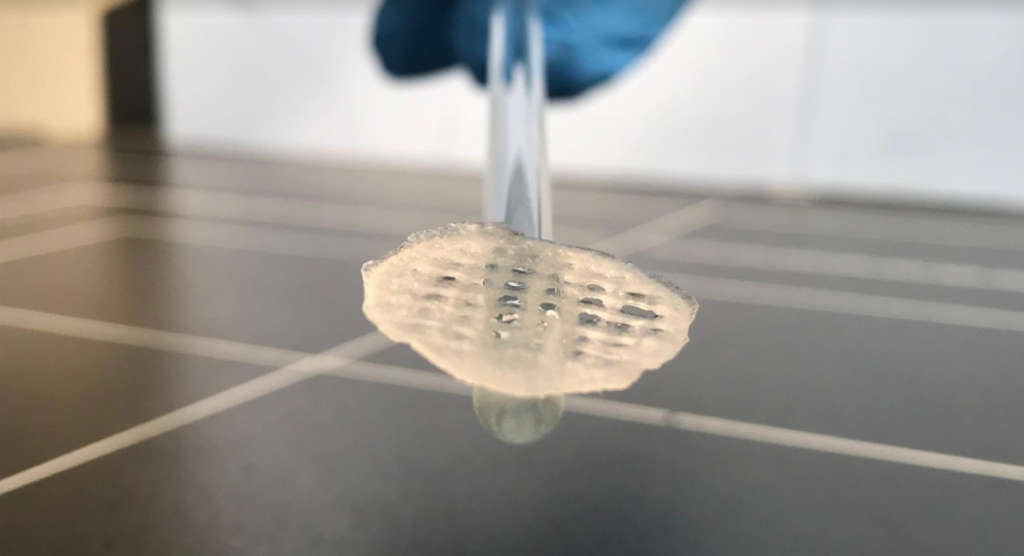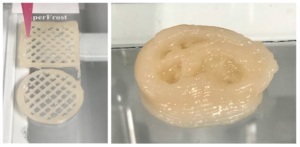 3D bioprinting is becoming an interesting alternative for medical professionals and research institutions that choose a more personalized treatment for their patients, this has potential to improve the quality of life and reduce costs to health systems. One of the countries where these new technologies are emerging is Spain. For the last eight years, REGEMAT 3D, one of the pioneering companies in the region, has been looking to achieve optimal clinical results through bioprinting and is quickly becoming an attractive option for the near future. Like many startups, the Granada-based company is also working hard to reduce drug and cosmetics testing on animals. Just last month, they revealed that researchers and pharmaceuticals using their biotechnology can reduce the time it takes for a drug to go through the development phases, making it available to patients quicker.
3D bioprinting is becoming an interesting alternative for medical professionals and research institutions that choose a more personalized treatment for their patients, this has potential to improve the quality of life and reduce costs to health systems. One of the countries where these new technologies are emerging is Spain. For the last eight years, REGEMAT 3D, one of the pioneering companies in the region, has been looking to achieve optimal clinical results through bioprinting and is quickly becoming an attractive option for the near future. Like many startups, the Granada-based company is also working hard to reduce drug and cosmetics testing on animals. Just last month, they revealed that researchers and pharmaceuticals using their biotechnology can reduce the time it takes for a drug to go through the development phases, making it available to patients quicker.
Historically, the drug development process has been long and costly. On average, it takes at least ten years for a new medicine to complete the journey from initial discovery to the marketplace, with clinical trials alone taking six to seven years. While the average cost to research and develop each successful drug is estimated at 2.6 billion dollars. The phases that a drug must go through before it becomes commercially available are as follows:
- Discovery and development: Research for a new drug begins in the lab
- Preclinical research: Drugs undergo lab and animal testing to answer basic questions about the safety
- Clinical research: Drugs are tested on people to make sure they are safe and effective, to know exactly the risks, benefits and side effects according to the characteristics of each patient
- Registration and authorization by the regulating agency: each country has a designated agency in charge of thoroughly examining all of the submitted data related to the drug or device and make a decision to approve or not to approve it
- Launch and post-market safety monitoring: monitoring of all drug and device safety once products are available for use by the public
With research into drugs developed with 3D biotechnology already producing some interesting results, the preclinical research phase is advancing and developing quicker. REGEMAT 3D is providing tools to pharmaceutical researchers engaged in developing new drugs and innovative solutions for patients. The company is collaborating with four research projects in drug delivery systems for colon disease, mesh prosthesis, wound dressings for the skin, and personalized drugs.
Using REGEMAT 3D’s V1 printer, Vicente Linares, a research collaborator and doctoral candidate of the Faculty of Pharmacy at the University of Seville, was able to manufacture for the first time pharmaceutical dosage forms with a 3D printer, combining Fused Deposition Modeling (FDM) and Injection Volume Filling (IVF), targeting the treatment of colon diseases (such as Crohn’s disease, colon cancer or ulcerative colitis). The integration of these two techniques allows an easier incorporation of drug/excipient liquid systems to the extruded scaffold at room temperature, avoiding other intermediate processes. Bioprinting has allowed Linares’ research to be carried out in vitro, obtaining positive results when administering medication to treat colon diseases.
According to the paper “Printfills: 3D printed systems combining fused deposition modeling and injection volume filling; application to colon-specific drug delivery,” published last January, in vitro studies show the ability for colon-specific drug delivery of the performed printfills (printed systems filled with a liquid or semisolid) thanks to the perfect sealing of the scaffold and the homogeneous layer obtained with the delaying release polymer. The advantages of this drug include reducing the amount of drug necessary for patient consumption and causing fewer side effects.

Linares: Digital design of printfills with drug represented by red points and the enteric polymer represented as green ones
Also developing a project in Seville is Francisco Jose Calero Castro, a specialist in biomedical investigation, who aims to produce a 3D mesh to simulate prostheses. In his paper, he claims that currently, hernia treatment involves implantation of a mesh prosthesis, usually made of polypropylene, which tends to become infected, leading to an exponential increase in morbidity. He used REGEMAT3D biotechnology to test a method of dealing with this type of complication. In his study, the bactericidal properties and effectiveness of 3D printed meshes with polycaprolactone (PCL) and gentamicin were evaluated in vitro in Escherichia coli cultures, and their histological behavior was examined in vivo. Different PCL meshes were implanted into four groups of rats, with a total of 36 manufactured microporous meshes and their bactericidal properties were assessed. Finally, the feasibility of manufacturing drug‐doped printed PCL meshes containing alginate and gentamicin was verified, and the meshes exhibited bactericidal effects and good histopathological behavior.
In Norway, Garry Chinga Carrasco, a lead scientist in the biocomposites area at RISE PFI AS, has also been working with REGEMAT 3D’s V1 bioprinter to create wound dressings for the skin and similar applications, like printing tissue models. Based on the findings published last July, soda-ethanol pulps, prepared from a forestry residue pine sawdust, were treated according to high-consistency enzymatic fibrillation technology to manufacture nanocellulose, which was used as ink for 3D printing of various structures. Carrasco successfully tested it for its moisture sorption capacity and cytotoxicity, as preliminary tests for evaluating its suitability for wound dressing and other applications.
Lastly, Carmen Alvarez-Lorenzo, professor of the Department of Pharmacy and Pharmaceutical Technology at the University of Santiago de Compostela (USC), is attempting to customize drugs, both the dosage and release profile, for regenerative medicine purposes. Instead of starting from a PLA filament preloaded with a given content of drug, she explored two more versatile strategies. The combination of the two proposed methods opened the possibility of creating concentration gradients of different drugs in the same scaffold. Tests were performed on scaffolds measuring their mechanical properties, biodegradation, and ability to promote cell attachment and proliferation. Finally, anti-inflammatory response and osteoinductive properties were verified in cell cultures.
 These are some of the most recent examples of productive partnerships between REGEMAT 3D and university researchers. The startup’s focus on regenerative medicine led it to develop custom hardware and software required and demanded by some of the major hospitals and research universities in the region, as well as creating bioinks for bioprinting. Although the company founder, José Manuel Baena, has previously explained to 3DPrint.com that the Spanish legislation is not an impediment for using the 3D printing machines, but is when it comes to the clinical phase, for now, research in Spain is moving quickly.
These are some of the most recent examples of productive partnerships between REGEMAT 3D and university researchers. The startup’s focus on regenerative medicine led it to develop custom hardware and software required and demanded by some of the major hospitals and research universities in the region, as well as creating bioinks for bioprinting. Although the company founder, José Manuel Baena, has previously explained to 3DPrint.com that the Spanish legislation is not an impediment for using the 3D printing machines, but is when it comes to the clinical phase, for now, research in Spain is moving quickly.
[Images: REGEMAT 3D]
Subscribe to Our Email Newsletter
Stay up-to-date on all the latest news from the 3D printing industry and receive information and offers from third party vendors.
You May Also Like
3D Printing Financials: Fathom Struggles in Financial Quicksand During Critical Transition
Facing a year of key transitions and financial pressures, Fathom (Nasdaq: FTHM) has filed its annual report for 2023 with the U.S. Securities and Exchange Commission (SEC). The document outlines...
Latest Earnings Overview for Australian 3D Printing Firms Titomic and AML3D
Australian 3D printing manufacturing firms Titomic (ASX: TTT) and AML3D (ASX: AL3) reported their financial results for the period from July to December 2023, marking the first half of their...
3D Printing Webinar and Event Roundup: April 7, 2024
Webinars and events in the 3D printing industry are picking back up this week! Sea-Air-Space is coming to Maryland, and SAE International is sponsoring a 3D Systems webinar about 3D...
3D Printing Financials: Unpacking Farsoon and BLT’s 2023 Performance
In the Chinese 3D printing industry, two companies, Farsoon (SHA: 688433) and Bright Laser Technologies, or BLT (SHA: 688333), have recently unveiled their full-year earnings for 2023. Farsoon reported increases...

































